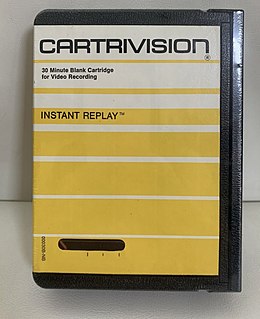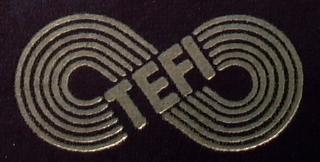The 8-track tape is a magnetic-tape sound recording technology that was popular in the United States from the mid-1960s to the early 1980s, when the Compact Cassette tape, which predated 8-track, surpassed it in popularity for pre-recorded music. The format is obsolete and was relatively unknown outside the United States, the United Kingdom, Canada, New Zealand, Australia, Germany, Italy, and Japan. The main advantage of the 8-Track tape cartridge is that it does not have to be "flipped over" to play the alternative set of tracks.
 W
WThe Bernoulli Box is a high-capacity removable floppy disk storage system that is Iomega's first widely known product. It was released in 1982.
 W
WBetamax is a consumer-level analog-recording and cassette format of magnetic tape for video. It was developed by Sony and was released in Japan on May 10, 1975. The first Betamax device introduced in the United States was the LV-1901 console, which included a 19-inch (48 cm) color monitor, and appeared in stores in early November 1975. The cassettes contain 0.50-inch-wide (12.7 mm) videotape in a design similar to that of the earlier, professional 0.75-inch-wide (19 mm), U-matic format. Betamax is obsolete, having lost the videotape format war to VHS. Despite this, Betamax recorders were not discontinued until August 2002. Betamax cassettes were available until March 2016, when Sony stopped making and selling them, alongside MicroMV.
 W
WBetamovie is the brand name for a range of consumer grade camcorders developed by Sony for the Betamax format. By "camcorder" is understood a single unit comprising a video camera and a video recorder.
 W
WThe Capacitance Electronic Disc (CED) is an analog video disc playback system developed by RCA, in which video and audio could be played back on a TV set using a special needle and high-density groove system similar to phonograph records.
 W
WCartrivision is an analog videocassette format introduced in 1972, and the first format to offer feature films for consumer rental.
 W
WThe Orb Drive is a 3.5-inch removable hard-disk drive introduced by Castlewood Systems in 1999. Its original capacity was 2.2 GB. A later version of the drive was introduced in 2001 with a capacity of 5.7 GB. Manufacturing of this product ceased in 2004.
 W
WCD Video is a format of optical media disc that was introduced in 1987 that combines the technologies of standard compact disc and LaserDisc. CD-V discs are the same size as a standard 12-cm audio CD, and contain up to 20 minutes' worth of CD Audio that can be played on any audio CD player. It also contains up to 5 minutes of LaserDisc video information with digital CD-quality sound, which can be played back on a newer LaserDisc player capable of playing CD-V discs or CD-V-only players.
 W
WCompact Video Cassette (CVC) was one of the first analog recording videocassette formats to use a tape smaller than its earlier predecessors of VHS and Betamax, and was developed by Funai Electronics of Japan for portable use. The first model of VCR for the format was the Model 212, introduced in 1980 by both Funai and Technicolor as they had created a joint venture to manufacture and introduce the format to the home movie market. The system, which included the VCR and a hand held video camera, was very small and lightweight for its time.
 W
WDC-International is a tape cassette format developed by Grundig and marketed in 1965. DC is the abbreviation of "Double Cassette", as the cassette contained two reels; International was intended to indicate that, from the beginning, several companies around the world supported the format with suitable tape cassette tape recorders, recorded music cassettes and blank cassettes. Since DC-International did not compete effectively against the similar Compact Cassette, it was discontinued in 1967.
 W
WThe Digital Compact Cassette (DCC) is a magnetic tape sound recording format introduced by Philips and Matsushita in late 1992 and marketed as the successor to the standard analog Compact Cassette. It was also a direct competitor to Sony's MiniDisc (MD), but neither format toppled the then-ubiquitous analog cassette despite their technical superiority, and DCC was discontinued in October 1996.
 W
WEIAJ-1 was a standard for video tape recorders (VTRs) developed by the Electronic Industries Association of Japan with the cooperation and assistance of several Japanese electronics manufacturers in 1969. It was the first standardized format for industrial/non-broadcast VTRs using a helical scan system employing open reel tape. Previously, each manufacturer of machines in this market used a different proprietary format, with differing tape speeds, scanner drum diameters, bias frequencies, tracking head placement, and so on, although most used 1/2" wide tape. As a result, video tapes recorded on one make and/or model of VTR could only be interchanged with other machines using that specific format, hampering compatibility. For example, a reel of tape recorded on a Panasonic machine would not play on a Sony machine, and vice versa. The EIAJ-1 standard ended this incompatibility, giving those manufacturers a standardized format, interchangeable with almost all VTRs subsequently brought to market around that time. The format offered black-and-white video recording and playback on 1/2″ magnetic tape on a 7″ diameter open reel, with portable units using smaller 5″ diameter reels.
 W
WElcaset is a short-lived audio format jointly developed by Panasonic, Sony, and Teac in 1976, building on an idea introduced 20 years earlier in the RCA tape cartridge.
 W
WThe Fidelipac, commonly known as a "NAB cartridge" or simply "cart", is a magnetic tape sound recording format, used for radio broadcasting for playback of material over the air such as radio commercials, jingles, station identifications, and music. Fidelipac is the official name of this industry standard audio tape cartridge. It was developed in 1954 by inventor George Eash, and commercially introduced in 1959 by Collins Radio at the 1959 NAB Convention. The cartridge was often used at radio stations until the late 1990s, when such formats as MiniDisc and computerized broadcast automation predominated.
 W
WFlexplay is a trademark for a discontinued DVD-compatible optical video disc format with a time-limited playback. They are often described as "self-destructing", although the disc merely turns black or dark red and does not physically disintegrate. The technology launched in August 2003 as a joint-venture with Disney's Buena Vista Home Entertainment under the name eZ-D. The Flexplay concept was invented by two professors, Yannis Bakos and Erik Brynjolfsson, who founded Flexplay Technologies in 1999. The technology was developed by Flexplay Technologies and General Electric.
 W
WHD DVD is an obsolete high-density optical disc format for storing data and playback of high-definition video. Supported principally by Toshiba, HD DVD was envisioned to be the successor to the standard DVD format.
 W
WIVC 2 inch Helical scan was a high-end broadcast quality helical scan analog recording VTR format developed by International Video Corporation (IVC), and introduced in 1975. Previously, IVC had made a number of 1 inch Helical VTRs. IVC saw a chance to make a VTR that would have the quality of the then-standard 2 inch Quadruplex videotape format but with the advantages of helical scan. They then developed a VTR using this technology, the IVC Model 9000.
 W
WLaserDisc (LD) is a home video format and the first commercial optical disc storage medium, initially licensed, sold and marketed as MCA DiscoVision in the United States in 1978. It is not a fully digital format and stores analog video signals.
 W
WMicroMV is a discontinued proprietary videotape format introduced in October 2001 by Sony. It is the smallest videotape format — 70% smaller than MiniDV or about the size of two US quarter coins; it is also smaller than a Digital8 or DV cassette and slightly smaller than an audio microcassette. It was the first helical scan tape system using MR read head introduced to the market. Each cassette can hold up to 60 minutes of video.
 W
WMiniDisc (MD) is a magneto-optical disc-based data storage format offering a capacity of 60, 74, and later, 80 minutes of digitized audio or 1 gigabyte of Hi-MD data. Sony brand audio players went on the market in September 1992.
 W
WMovieCD is a format for digital video storage and consumer home video playback released in 1996 by Sirius Publishing, and was rendered obsolete by the wider distribution of DVD. It used a video codec called MotionPixels, marketed by MotionPixels, Inc., a subsidiary of Sirius Publishing. It was used in many third-party video games from the mid to late-1990s, and during the same time on Sirius's MovieCDs that it had been originally developed for, enjoying an international distribution in both forms.
 W
WPlayTape is a 1⁄8 inch (3.2 mm) audiotape format and mono or stereo playback system introduced in 1966 by Frank Stanton. It is a two-track system, and was launched to compete with existing 4-track cartridge technology. The cartridges play anywhere from eight to 24 minutes, and are continuous. Because of its portability, PlayTape was an almost instant success, and over 3,000 artists had published in this format by 1968. White cases usually meant about eight songs were on the tape.
 W
WQuadraphonic open reel tape or Q4 was the first medium for quadraphonic sound recording and playback, introduced to the American market by the Vanguard Recording Society in June 1969.
 W
W2-inch quadruplex videotape was the first practical and commercially successful analog recording video tape format. It was developed and released for the broadcast television industry in 1956 by Ampex, an American company based in Redwood City, California. The first videotape recorder using this format was built in the same year. This format revolutionized broadcast television operations and television production, since the only recording medium available to the TV industry before then was film used for kinescopes, which was much more costly to utilize, could only be used once, images could be ruined by light leaks if the film was not developed and took time to develop at a film laboratory. In addition, kinescope images were usually of obviously inferior quality to the live television broadcast images they recorded, whereas quadruplex videotape preserved almost all the image detail of a live broadcast.
 W
WThe RCA tape cartridge is a magnetic tape audio format that was designed to offer stereo quarter-inch reel-to-reel tape recording quality in a convenient format for the consumer market. It was introduced in 1958, following four years of development. This timing coincided with the launch of the stereophonic phonograph record. It was introduced to the market by RCA in 1958.
 W
WSabamobil was a magnetic tape audio cartridge format made by SABA that came to the market in 1964. It used already-available four-track ¼ inch tape on 3-inch reels (7.62 cm), with two mono channels per side, using a tape speed of 3¾ ips (9.5 cm/s), and was compatible with reel-to-reel audio tape recording except the against remove secured ends of the tape in the reel. The cartridge could be opened without the need of any tools by removing two holding clamps. Tape head and capstan were placed between the reels.
 W
WThe Sanyo Micro Pack 35 was a portable magnetic audio tape recording device, developed by Sanyo in 1964, that employed a special tape cartridge format with tape reels atop each other.
 W
WSmartMedia is a flash memory card standard owned by Toshiba, with capacities ranging from 2 MB to 128 MB. SmartMedia memory cards are no longer manufactured.
 W
WThe Muntz Stereo-Pak, commonly known as the 4-track cartridge, is a magnetic tape sound recording cartridge technology. The in-car tape player that played the Stereo-Pak cartridges was called the Autostereo, but it was generally marketed under the common Stereo-Pak trade name.
 W
WTelevision Electronic Disc (TeD) is a discontinued video recording format, released in 1975 by Telefunken and Teldec. The format used 8-inch-diameter (200 mm) flexible foil discs, which spun at 1,500 rpm on a cushion of air. TeD never gained wide acceptance, and could not compete against the emerging videocassette systems of the time.
 W
WThe Tefifon is an audio playback format, developed and manufactured in Germany, that utilizes cartridges loaded with an endlessly looped reel of plastic tape. It is somewhat similar to the later 4-track and 8-track magnetic audio tape cartridges, but with grooves embossed on the tape, like a phonograph record. The grooves were embossed in a helical fashion across the width of the tape, in a manner similar to Dictaphone's Dictabelt format. The grooves are read with a stylus and amplified pickup in the player's transport. A Tefifon cartridge, known as a "Tefi", can hold up to four hours of music; therefore, most releases for the format are usually compilations of popular hits or dance music, operas and operettas. Tefifon players were not sold by television and radio dealers in Germany, but rather sold directly by special sales outlets affiliated with Tefi.
 W
WU-matic is an analogue recording videocassette format first shown by Sony in prototype in October 1969, and introduced to the market in September 1971. It was among the first video formats to contain the videotape inside a cassette, as opposed to the various reel-to-reel or open-reel formats of the time. The videotape is 3⁄4 in (19 mm) wide, so the format is often known as "three-quarter-inch" or simply "three-quarter", compared to open reel videotape formats in use, such as 1 in (25 mm) type C videotape and 2 in (51 mm) quadruplex videotape.
 W
WThe Universal Media Disc (UMD) is a discontinued optical disc medium developed by Sony for use on their PlayStation Portable handheld gaming and multimedia platform. It can hold up to 1.8 gigabytes of data and is capable of housing video games, feature-length films, and music. UMD was the trademark of Sony Computer Entertainment for their optical disk cartridge (ODC).
 W
WVHS is a standard for consumer-level analog video recording on tape cassettes. Developed by Victor Company of Japan (JVC) in the early 1970s, it was released in Japan on September 9, 1976, and in the United States on August 23, 1977.
 W
WVideo 2000 is a consumer videocassette system and analogue recording standard developed by Philips and Grundig to compete with JVC's VHS and Sony's Betamax video technologies. Designed for the PAL color television standard, distribution of Video 2000 products began in 1979 exclusively in Europe, South Africa and Argentina and ended in 1988.
 W
WVideo Cassette Recording (VCR) is an early domestic analog recording format designed by Philips. It was the first successful consumer-level home videocassette recorder (VCR) system. Later variants included the VCR-LP and Super Video (SVR) formats.
 W
WVideo Single Disc (VSD) is a disc-based format that carried the same analog video information as a LaserDisc, but on a 12-centimetre diameter CD-DA-sized disc. It was spearheaded by Sony and was released in Japan in 1990. It was a new variety of laserdisc and variation on the CD Video (CD-V) format, except that VSD disc carried only video. The disc is the same size as a standard CD and holds five minutes of video with digital sound. It did not have any additional audio tracks like CD-V. Like CD-V, VSD discs could be played back by multi-disc or LaserDisc players that had VSD playback capability.
 W
WWire recording or magnetic wire recording was the first magnetic recording technology, an analog type of audio storage in which a magnetic recording is made on a thin 37 gauge (0.004") steel wire. The first crude magnetic recorder was invented in 1898 by Valdemar Poulsen. The first magnetic recorder to be made commercially available anywhere was the Telegraphone, manufactured by the American Telegraphone Company, Springfield, Massachusetts.
 W
WxD-Picture Card is an obsolete form of flash memory card, used in digital cameras made by Olympus and Fujifilm during the 2000s. The xD in the xD-Picture Card stands for eXtreme Digital.